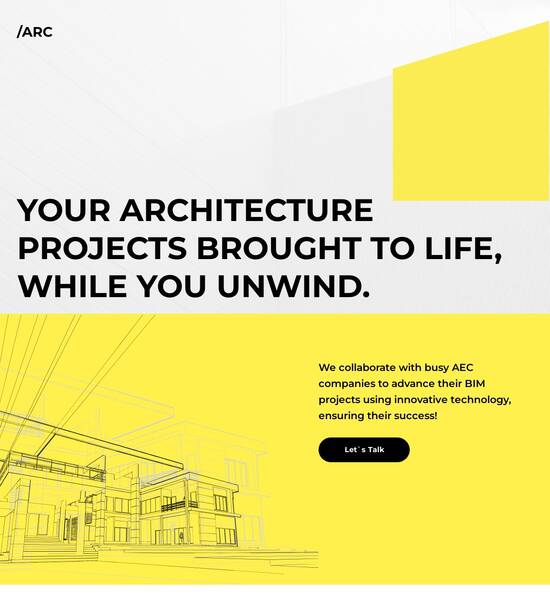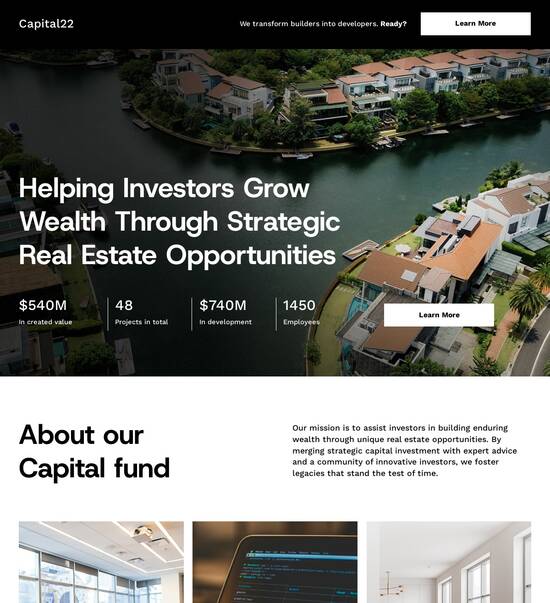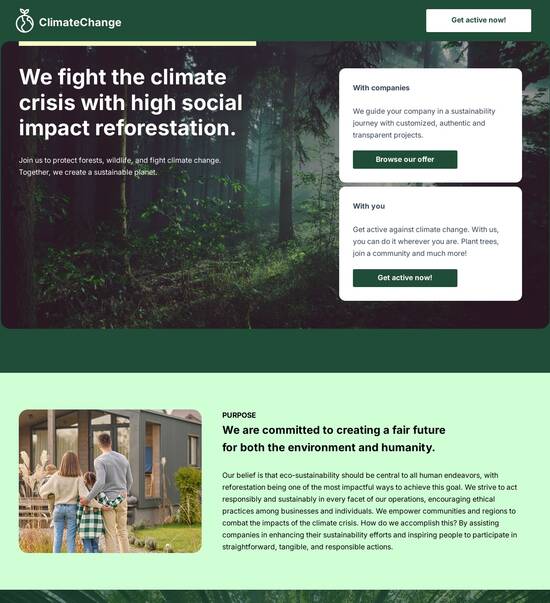
React.js optimized order history page template
Explore Similar TemplatesAbout template
Supercharge your order history page with React.js for outstanding performance! Learn more today.
Recommended templates

Easy to build without coding
With the intuitive drag-and-drop builder, anyone on your team can create high-converting pages without any knowledge of code or design. Make enhancements to your landing page with custom widgets using Javascript, HTML/CSS, or third-party scripts.

Multiple layouts for any industry and goal
Select from 500+ landing page layouts built to boost conversions across industry-specific scenarios. Customize them by adjusting fonts, adding images, and generating on-brand content with the AI assistant. Quickly scale with Instablocks® and Global Blocks that you can save, reuse, and update globally.

Loads fast and looks polished on any device
Every template is responsive, which means they present professionally on any device and load blazingly fast with our Thor Render Engine. You can also power them up with Google AMP technology to deliver an unparalleled mobile experience and drive higher conversions.

Robust analytics & experimentation
Get real-time updates and reporting across all your devices, showing the number of visitors, conversions, cost-per-visitor, and cost-per-lead. Launch AI-powered experiments, run A/B tests, and use heatmaps to analyze user behavior, then optimize your landing page to maximize conversions.







Easy to build without coding
With the intuitive drag-and-drop builder, anyone on your team can create high-converting pages without any knowledge of code or design. Make enhancements to your landing page with custom widgets using Javascript, HTML/CSS, or third-party scripts.
Multiple layouts for any industry and goal
Select from 500+ landing page layouts built to boost conversions across industry-specific scenarios. Customize them by adjusting fonts, adding images, and generating on-brand content with the AI assistant. Quickly scale with Instablocks® and Global Blocks that you can save, reuse, and update globally.
Loads fast and looks polished on any device
Every template is responsive, which means they present professionally on any device and load blazingly fast with our Thor Render Engine.
Robust analytics & experimentation
Get real-time updates and reporting across all your devices, showing the number of visitors, conversions, cost-per-visitor, and cost-per-lead. Launch AI-powered experiments, run A/B tests, and use heatmaps to analyze user behavior, then optimize your landing page to maximize conversions.
All the features you need to build lead-generating landing pages
Explore more featuresLearn how to build top-performing landing pages for any goal
FAQs
Leading the way in building high-performing landing pages





Unlock the potential of your campaigns with Instapage's powerful landing page and CRO platform
Instapage is unrivaled in the digital marketing realm, providing marketers with the tools to accelerate and optimize landing page creation. With its robust features designed for diverse industries, including business services and education, Instapage streamlines the landing page building process while maximizing ROI for your campaigns. Whether you’re in tech/SaaS or financial services, the platform has unique solutions tailored to your needs.
Discover Instapage’s Templates and Lead Generation Elements
One of Instapage's standout offerings is access to over 100 high-converting templates. These templates come with pre-built lead generation elements that allow marketers to launch effective campaigns swiftly. This is particularly beneficial for teams of all sizes, enabling them to capture leads effectively without having to start from ground zero.
- Ready-to-use templates: These are professionally designed pages that are fully customizable.
- Pre-built lead generation tools: Streamline the process of capturing visitor information.
- Intuitive builders: Drag-and-drop functionality that makes page creation accessible to everyone.
Build High-Quality Landing Pages Without Coding
Instapage allows you to create landing pages swiftly and efficiently. The platform's library of conversion-focused layouts ensures flexibility while eliminating the need for coding or developer input.
Optimize Your Campaign with Built-in Experimentation
To ensure that your landing pages are performing at their best, Instapage comes equipped with built-in optimization features.
- Detailed heatmaps: Understand user behavior on your pages.
- A/B testing: Efficiently compare variations to discover which performs better.
- Analytics dashboard: Assess your landing page performance metrics at a glance.
Personalize Your Content for Maximum Engagement
Creating tailored content that speaks directly to your audience can dramatically boost engagement. Instapage’s personalization features enable dynamic text replacement based on user demographics.
- Dynamic text replacement: Customize headlines or content based on user data.
- AdMaps: Efficient alignment of ads to specific landing pages.
- Audience-level metrics: Analyze how various segments interact with your landing pages.
In conclusion, Instapage stands as a comprehensive solution for marketers aiming to optimize and maximize ROI through expertly crafted landing pages.
Ready to transform your marketing strategy? Explore Instapage today and discover the tools that will elevate your campaigns to the next level.
ReactJS optimized order history page template
Understanding the foundation of an optimized order history page
In e-commerce, the order history page serves as a vital touchpoint for customers, allowing them to review prior purchases and track ongoing orders. It plays a key role in shaping overall user experience, which can significantly influence a customer’s satisfaction and loyalty. Well-structured order history pages not only enhance user engagement but can also positively impact sales metrics through repeat purchases.
Streamlined order history pages simplify navigation, provide instant access to relevant information, and foster customer trust. They are essential in retaining customers who often seek hassle-free access to their purchase history. Several case studies have shown that companies offering an intuitive order history experience report higher retention rates, leading to increased revenue and customer satisfaction.
Purpose and importance of order history pages
Role of order history in enhancing customer loyalty and retention
Case studies demonstrating the impact of streamlined order history pages
Core features of an effective order history page template
A successful order history page should include features that cater to user needs and improve their experience. One of the primary components is order tracking, which provides customers with real-time updates regarding their purchases. Implementing live tracking features delivers reassurance to customers by allowing them to monitor their orders’ status and estimated delivery time, enhancing the overall retention strategy.
Another crucial feature is a robust search component. Designing intuitive search functionalities ensures users can quickly find specific orders, maximizing efficiency. Advanced filtering options, such as sorting by date, order status, or item, empower customers to navigate their purchase history with ease. Additionally, incorporating preview options allows users to see previous orders at a glance, which simplifies the process of making repeat purchases or resolving issues.
Order tracking
Search component
Preview options for previous orders
Technological framework behind an optimized order history page
Utilizing ReactJS for developing an order history page offers numerous advantages, especially for creating flexible user interfaces. ReactJS allows for dynamic rendering, which means content updates can occur seamlessly without reloading the entire page. Moreover, effective state management practices within React enable efficient handling of user interactions and data display without compromising performance.
Integrating backend technologies further enhances the order history page functionality. Utilizing APIs is essential for fetching historical order data. Common technologies such as Node.js, Express, and MongoDB serve as a solid foundation for establishing a reliable server-side setup that can provide smooth, real-time data interactions. Caching and database optimization are crucial to ensure rapid responses to user queries.
Utilizing ReactJS for flexible UI components
Integration with backend technologies
Performance optimization techniques
Engaging users through innovative content presentation
Designing user-focused interfaces is paramount for creating an effective order history page. Best practices in UI/UX design should focus on simplicity and clarity, ensuring users can quickly access the information they seek. Implementing responsive layouts allows the page to function seamlessly across various devices, from desktops to mobile phones. Accessibility considerations must also be integrated to cater to users with diverse needs.
Displaying order details effectively can involve choosing between formats such as tables or card layouts. Utilizing icons and graphics can enhance clarity and guide users through their order history effortlessly. Partnering these design choices with user feedback mechanisms proves invaluable for continuous improvement, as it allows developers to refine the user experience based on real interactions and suggestions.
Best practices for UI/UX design
Use of responsive layouts for diverse devices
Incorporating user feedback mechanisms for content improvement
Building community engagement and knowledge sharing
Creating a community-driven Q&A section on the order history page fosters user interaction and enhances support. This feature allows users to ask questions related to their orders, which elevates the overall value of the page. Implementing a 'Frequently Asked Questions' module can streamline common queries and reduce customer support burden while empowering users to troubleshoot minor issues independently.
Moreover, fostering a collectives environment encourages users to share experiences and suggestions. Integrating community forums allows customers to exchange ideas and expectations about features they wish to see in the order history page, which provides insights for future updates. Such initiatives enhance customer loyalty by making users feel valued as contributors to the product’s evolution.
Importance of community-driven knowledge transfer
Implementation of a Q&A module
Strategies to encourage user interaction and suggestions
Tracking and analyzing user interactions
Implementing tracking mechanisms allows businesses to monitor user actions on the order history page. Understanding user behavior is crucial for identifying pain points and areas for improvement. Utilizing tools like Google Analytics or Mixpanel enables comprehensive data collection and analysis, which helps businesses make informed decisions regarding feature enhancements.
Data collection should occur continuously to fuel improvements, encompassing aspects such as engagement metrics and conversion rates. A/B testing different page versions provides valuable insights into user preferences. This iterative approach not only refines the order history experience but also ensures that the platform adapts over time to meet changing user needs.
Types of user actions to monitor on the order history page
Tools and technologies for tracking
Engagement metrics for measuring order history page success
The role of development teams and their collaboration
The development of an optimized order history page requires close collaboration among cross-functional teams, including developers, designers, and marketers. This synergy is crucial in identifying user requirements and effectively translating them into the final product. Adopting agile methodologies fosters an iterative development process, allowing teams to quickly address changes based on user feedback or shifting market demands.
Moreover, establishing a sustainable development environment underpins the success of such projects. Utilizing tools for version control, such as Git and GitHub, enhances collaboration and ensures that teams can track changes efficiently. Implementing rigorous code review and quality assurance practices can improve the product's robustness, making sure that the order history page remains functional and user-friendly.
Importance of collaboration between developers, designers, and marketers
Agile methodologies for iterative development
Tools for version control and collaboration
Future trends in order history page features
As technology continues to evolve, so too does the potential for enhancing order history pages. Predictive analysis and AI integration are emerging trends that can significantly improve the user experience. By leveraging order history data, businesses can provide personalized recommendations based on previous purchases, thus streamlining the buying process for customers.
Furthermore, integrating community features such as social sharing of order history highlights can foster engagement. Gamification elements that reward customers for frequent purchases or interactions can drive user loyalty. However, alongside these advancements, it is crucial to prioritize privacy and security, ensuring that customer data remains protected at all times.
Enhancing user experience through personalized recommendations
Potential for integrating social sharing features
Strategies for ensuring user data protection
Practical implementation steps
To build an optimized order history page, developers should follow a structured blueprint that guides them through each stage, from design to deployment. This includes outlining the necessary features, selecting appropriate technologies, and defining the user interface. Central to this blueprint is a checklist comprising the technologies required for the project, from front-end frameworks like ReactJS to back-end solutions such as Node.js.
Developers should also be aware of common pitfalls that can hinder the effectiveness of the order history page. For instance, a lack of user-focused design can lead to frustration and disengagement. By addressing typical user experience issues proactively, developers can ensure that the page serves its purpose efficiently while maximizing user satisfaction. Learning from real-world case studies can provide valuable insights into best practices and methodologies for optimization.
Step-by-step guide from design to deployment
Checklist of necessary technologies and tools
Lessons learned from industry leaders
Ready to skyrocket conversions?
Supercharge your ad campaigns with high-performing landing pages
Get started














